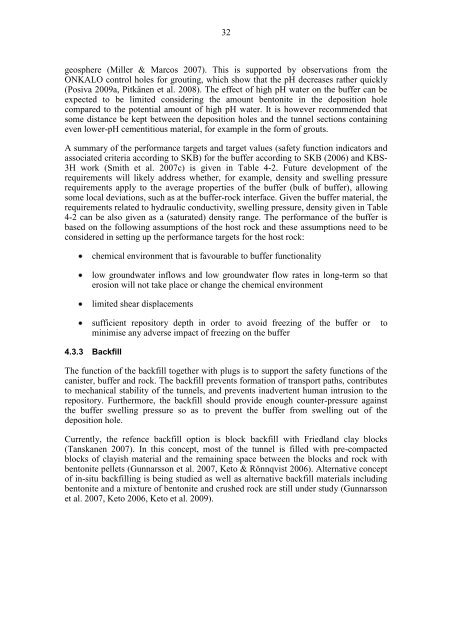RSC-Programme - Interim Report. Approach and Basis for - Posiva
RSC-Programme - Interim Report. Approach and Basis for - Posiva
RSC-Programme - Interim Report. Approach and Basis for - Posiva
You also want an ePaper? Increase the reach of your titles
YUMPU automatically turns print PDFs into web optimized ePapers that Google loves.
32geosphere (Miller & Marcos 2007). This is supported by observations from theONKALO control holes <strong>for</strong> grouting, which show that the pH decreases rather quickly(<strong>Posiva</strong> 2009a, Pitkänen et al. 2008). The effect of high pH water on the buffer can beexpected to be limited considering the amount bentonite in the deposition holecompared to the potential amount of high pH water. It is however recommended thatsome distance be kept between the deposition holes <strong>and</strong> the tunnel sections containingeven lower-pH cementitious material, <strong>for</strong> example in the <strong>for</strong>m of grouts.A summary of the per<strong>for</strong>mance targets <strong>and</strong> target values (safety function indicators <strong>and</strong>associated criteria according to SKB) <strong>for</strong> the buffer according to SKB (2006) <strong>and</strong> KBS-3H work (Smith et al. 2007c) is given in Table 4-2. Future development of therequirements will likely address whether, <strong>for</strong> example, density <strong>and</strong> swelling pressurerequirements apply to the average properties of the buffer (bulk of buffer), allowingsome local deviations, such as at the buffer-rock interface. Given the buffer material, therequirements related to hydraulic conductivity, swelling pressure, density given in Table4-2 can be also given as a (saturated) density range. The per<strong>for</strong>mance of the buffer isbased on the following assumptions of the host rock <strong>and</strong> these assumptions need to beconsidered in setting up the per<strong>for</strong>mance targets <strong>for</strong> the host rock:chemical environment that is favourable to buffer functionalitylow groundwater inflows <strong>and</strong> low groundwater flow rates in long-term so thaterosion will not take place or change the chemical environmentlimited shear displacementssufficient repository depth in order to avoid freezing of the buffer orminimise any adverse impact of freezing on the bufferto4.3.3 BackfillThe function of the backfill together with plugs is to support the safety functions of thecanister, buffer <strong>and</strong> rock. The backfill prevents <strong>for</strong>mation of transport paths, contributesto mechanical stability of the tunnels, <strong>and</strong> prevents inadvertent human intrusion to therepository. Furthermore, the backfill should provide enough counter-pressure againstthe buffer swelling pressure so as to prevent the buffer from swelling out of thedeposition hole.Currently, the refence backfill option is block backfill with Friedl<strong>and</strong> clay blocks(Tanskanen 2007). In this concept, most of the tunnel is filled with pre-compactedblocks of clayish material <strong>and</strong> the remaining space between the blocks <strong>and</strong> rock withbentonite pellets (Gunnarsson et al. 2007, Keto & Rönnqvist 2006). Alternative conceptof in-situ backfilling is being studied as well as alternative backfill materials includingbentonite <strong>and</strong> a mixture of bentonite <strong>and</strong> crushed rock are still under study (Gunnarssonet al. 2007, Keto 2006, Keto et al. 2009).
















